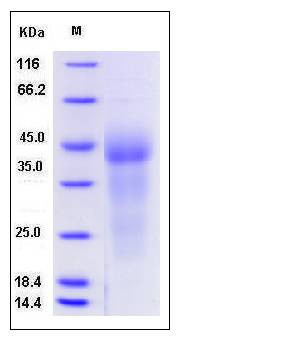Human GPR37 Protein (His Tag)
EDNRBL,hET(B)R-LP,PAELR
- 100ug (NPP2169) Please inquiry
| Catalog Number | P13496-H08H |
|---|---|
| Organism Species | Human |
| Host | Human Cells |
| Synonyms | EDNRBL,hET(B)R-LP,PAELR |
| Molecular Weight | The secreted recombinant human GPR37 comprises 250 amino acids and has a predicted molecular mass of 26.6 kDa. ? The apparent molecular mass of rh GPR37 is approximately 30-45 kDa in SDS-PAGE under reducing conditions due to different glycosylation. |
| predicted N | Ala 27 |
| SDS-PAGE |  |
| Purity | > 80 % as determined by SDS-PAGE |
| Protein Construction | A DNA sequence encoding the human GPR37 (NP_005293.1) the first extracellular domaqin (Met 1-Met 265) was fused with a polyhistidine tag at the C-terminus. |
| Bio-activity | |
| Research Area | Immunology |Signal Transduction |Signaling Pathway |G Protein Signaling |G Protein-Coupled Receptors (GPCRs) |Orphan G Protein-Coupled Receptors | |
| Formulation | Lyophilized from sterile PBS, pH 7.4 1. Normally 5 % - 8 % trehalose and mannitol are added as protectants before lyophilization. Specific concentrations are included in the hardcopy of COA. |
| Background | GPR37 (cathepsin Z) is an orphan receptor which belongs to the G-protein coupled receptor 1 family. G protein coupled receptors is a large protein family comprised by transmembrane receptors that sense molecules outside the cell and activate inside signal transduction pathways and, ultimately, cellular responses. They only exists in eukaryotes, including yeast, choanoflagellates, and animals. These receptors are binded and activated by light-sensitive compounds, odors, pheromones, hormones, and neurotransmitters. These ligands vary in size from small molecules to peptides to large proteins. G protein-coupled receptors are involved in many diseases, and are also the target of approximately 40% of all modern medicinal drugs. GPR37 is expressed in brain and spinal cord, and at lower levels in testis, placenta and liver, but no detectable expression observed in any other tissue. GPR37 may have a unique functional role in the central nervous system. |
| Reference |
